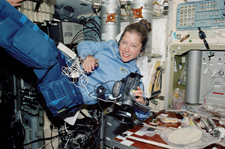
The commanders of both space shuttle
Discovery (STS-120) and the International Space Station (ISS), the two crewed spacecraft now in orbit, are women. So, this week in the interstellar media, headlines gush with a milestone in the annals of gender. "Women set to take charge of space," said
IEEE Spectum Online. "A great leap for womankind," notes
Yahoo! News. You get the idea.
This raises a complicated question. Is this kind of media coverage harmful or helpful to women?
On one hand, having two women in orbit, both in leadership positions, is notable — although it must be clear this was an accident of scheduling, not two women joining forces to triumph over discrimination. Shuttle commander Pamela Melroy and station commander Peggy Whitson were simply up to the job and got their chance to serve in due course.
However, some women interested in science, engineering, and aviation will inevitably perceive Melroy and Whitson as role models. Publicizing the "two women in orbit" story buys some valuable attention for NASA's programs and, perhaps, does some social good by inspiring young women to follow their dreams into space. Who could oppose that?
The other side of the story is that by spotlighting Melroy and Whitson as "women astronauts" instead of just astronauts, it may feed the perception of "female astronaut" as an exception to some unstated rule and, therefore, in some sense an aberration.
This reminds me of a gender-related episode involving women in the media. I worked my way through graduate school reporting on campus science for the university public-relations machine. Fortunately, I went to one of the great public research universities, the University of Wisconsin, Madison.
UW-M employs scores of top-shelf scientists and engineers. One of my colleagues was assigned to profile one of our accomplished engineers — not as an accomplished engineer who happened to be female, but as a female engineer. As in, "So, is it tough to be a female engineer?" The engineer in question politely declined to be involved in such an article. "What are you going to call it?" she asked my colleague. "The girls of engineering?"
I guess this is one for social scientists to work out. But you can't help but want to give Melroy and Whitson a hearty "Godspeed and good luck," because when they were born, the very idea of launching a female commander into space, much less two of them, was virtually unthinkable.
Dare I say, "You've come a long way, baby?" Yes, indeed: 290 miles (460 km), the space station's maximum altitude above Earth.